STIHL E 20 Owner's Manual
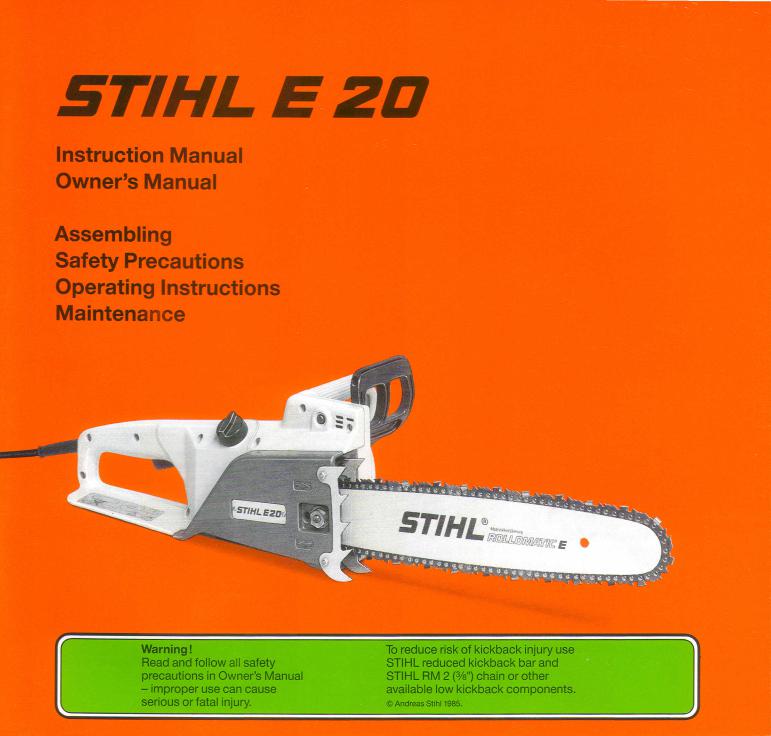

Important Safety Precautions for Chain Saw Users
A.
Kickback Safety Precautions
!Warning!
Kickback may occur when the nose or tip of the guide bar touches an object, or when the wood closes in and pinches the saw chain in the cut. Tip contact in some cases may cause a lightning fast reverse reaction, kicking the guide bar up and back towards the operator. Pinching the saw chain along the top of the guide bar may push the guide bar rapidly back towards the operator. Either of these reactions may cause you to lose control of the saw which could result in serious personal injury.
Section 5.12 of ANSI B 175.1-2000 sets certain performance and design criteria related to chainsaw kickback. STIHL has developed a color code system using green and yellow to help you select a powerhead, bar and chain combination that complies with the kickback requirements of the ANSI Standard. See the sections entitled "Safety Precautions" and "Specifications" of this manual.
Do not rely exclusively upon the safety devices built into your saw. As a chainsaw user, you should take several steps to keep your cutting jobs free from accident or injury.
1.With a basic understanding of kickback, you can reduce or eliminate the element of surprise. Sudden surprise contributes to accidents.
2.Keep a good firm grip on the saw with both hands, the right hand on the rear handle, and the left hand on the front handle, when the engine is running. Use a firm grip with thumbs and fingers encircling the chainsaw handles. A firm grip will help you reduce kickback and maintain control of the saw. Don't let go.
3.Make sure the area in which you are cutting is free from obstructions. Do not let the nose of the guide bar contact a log, branch, or any other obstruction while you are operating the saw.
4.Cut at high engine speeds.
5.Do not overreach or cut above shoulder height.
6.Follow manufacturer's sharpening and maintenance instructions for the saw chain.
7.Only use replacement bars and chains specified by the manufacturer or the equivalent.
B.
Other Safety Precautions
1.Do not operate a chainsaw with one hand! Serious injury to the operator, helpers, bystanders, or any combination of these persons may result from one-handed operation. A chainsaw is intended to be used with two hands.
2.Do not operate a chainsaw when you are fatigued.
3.Use safety footwear; snug-fitting clothing; protective gloves; and eye, hearing, and head protection devices.
4.Do not allow other persons to be near the chainsaw when starting or cutting with the chainsaw. Keep bystanders and animals out of the work area.
continued on the back inside cover
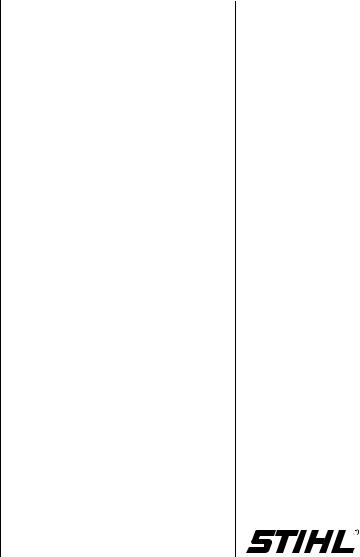
Contents
Main Parts and Controls |
2 |
Definitions |
3 |
Safety Precautions |
4 |
Mounting the Bar and Chain |
23 |
Tensioning the Saw Chain |
24 |
Checking Chain Tension |
24 |
Chain Oil |
24 |
Filling Chain Oil Tank |
25 |
Chain Brake |
25 |
Connecting Saw to Power Supply |
26 |
Switching On |
26 |
Switching Off |
26 |
Overload Circuit Breaker |
27 |
Checking Chain Lubrication |
27 |
During Operation |
28 |
After Finishing Work |
28 |
Taking Care of Guide Bar |
28 |
Checking and Replacing |
|
the Chain Sprocket |
29 |
Motor Cooling |
30 |
Storing the Machine |
30 |
Printed on chlorine-free paper
Printing inks contain vegetable oils, paper is recyclable
2002 Andreas Stihl AG & Co., Waiblingen
0458 107 3021. M0,75. B2. Rei. Printed in Germany
Maintaining and Sharpening |
|
the Saw Chain |
31 |
Maintenance Chart |
34 |
Specifications |
35 |
Ordering Spare Parts |
36 |
Adresses |
36 |
This manual contains operating and safety instructions for all STIHL E 220 series chainsaws.
Pay special attention to the safety precautions outlined on pages 4 to 20. Allow only persons who understand this Manual to operate your chainsaw.
To receive maximum performance and satisfaction from your STIHL chainsaw, it is important that you read and understand the maintenance and safety precautions before using your saw. Contact your STIHL dealer or the STIHL distributor for your area if you do not understand any of the instructions in this Manual.
Warning!
Because a chainsaw is a high-speed wood-cutting tool, some special safety precautions must be observed as with any other power saw to reduce the risk of personal injury. Careless or improper use may cause serious or even fatal injury. STIHL’s philosophy is to continually improve all of its products. As a result, engineering changes and improvements are made from time-to-time.
If the operating characteristics or the appearance of your saw differ from those described in this Manual, please contact your STIHL dealer for information and assistance.
E 220 |
1 |
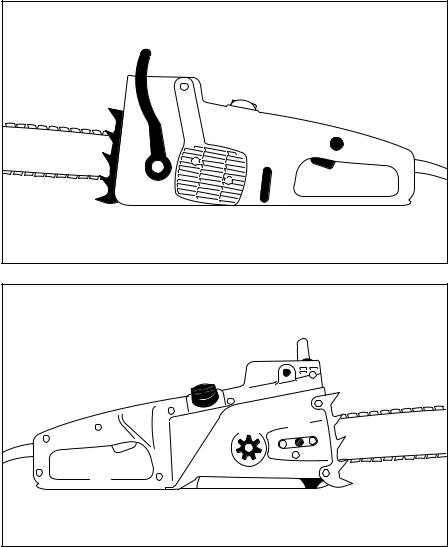
0DLQ 3DUWV DQG &RQWUROV |
|
|
|
|
|
4 |
|
|
|
2 |
5 |
|
|
|
1 |
|
|
|
6 |
|
|
|
|
|
|
|
8 |
7 |
|
|
|
|
|
|
|
3 |
|
|
KN |
|
|
|
|
107BA014 |
|
22 |
23 |
|
|
|
21 |
25 |
24 |
|
|
|
|
|
|
|
26 |
|
|
|
|
20 |
|
27 |
|
|
|
|
LA |
|
|
|
|
107BA019 |
|
|
|
|
|
|
|
|
|
|
|
(matic guide bar
Oilomatic saw chain
Bumper spike
Front hand guard
Front handle
Interlock button
Trigger switch
Oil inspection window
Rear hand guardRear handle
Oil filler cap
Overload circuit breaker
Side chain tensioner
Chain sprocket
Chain sprocket cover
Chain catcher
(
'HILQLWLRQV
(PDWLF *XLGH %DU |
5HDU +DQG *XDUG |
*XLGH %DU 1RVH |
||
|
Supports and guides the saw chain. |
|
Gives added protection to |
The exposed end of the guide bar. |
|
|
|
operator’s right hand. |
(not illustrated, see chapter |
|
2LORPDWLF 6DZ &KDLQ |
|
|
“Mounting the Bar and Chain”). |
|
A loop consisting of cutters, tie |
|
5HDU +DQGOH |
|
|
straps and drive links. |
|
The support handle for the right |
&KDLQ *XDUG 6FDEEDUG |
|
|
|
hand, located at or toward the |
To protect the operator from touching |
|
%XPSHU 6SLNH |
|
rear of the saw. |
the chain (not illustrated). |
|
Toothed stop for holding saw steady |
|
|
|
|
against wood. |
|
2LO )LOOHU &DS |
|
For closing the oil tank.
)URQW +DQG *XDUG
|
Provides protection against |
2YHUORDG &LUFXLW %UHDNHU |
|
projecting branches and helps |
Interrupts power supply when |
|
prevent left hand from |
exessive infeed force is used or |
|
touching the chain if it slips off |
when chain becomes pinched in |
|
the handle bar. |
cut. Motor stops. |
|
)URQW +DQGOH |
6LGH &KDLQ 7HQVLRQHU |
|
Handle bar for the left hand at |
Permits precise adjustment of chain |
|
front of saw. |
tension. |
|
,QWHUORFN EXWWRQ |
&KDLQ 6SURFNHW |
|
Must be depressed before the |
The toothed wheel that drives the |
|
trigger switch can be activated. |
saw chain. |
7ULJJHU 6ZLWFK |
&KDLQ 6SURFNHW &RYHU |
|
|
Controls the speed of the motor. |
Covers the clutch and the sprocket. |
2LO ,QVSHFWLRQ :LQGRZ |
&KDLQ &DWFKHU |
|
|
For visually checking the oil level. |
Helps to reduce the risk of operator |
|
|
contact by a chain if it breaks |
|
|
or comes off the bar. |
( |
|
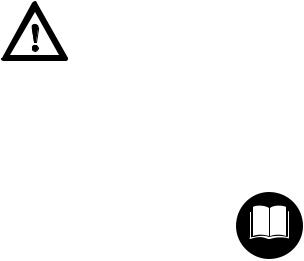
english / USA
SAFETY PRECAUTIONS
The use of any chainsaw may be hazardous. The saw chain has many
sharp cutters. If the cutters contact your flesh, they will cut you, even if
the chain is not moving. At full throttle, the chain speed can reach 45 mph (20 m/s). It is important that you read, fully understand and observe the following safety precautions and warnings. Read the Owner's Manual
and the Safety Precautions periodically.
Pay special attention to the section on reactive forces.
!Warning!
Reactive forces, including kickback, can be dangerous. Careless or improper use of any chainsaw may cause serious or fatal injury.
All safety precautions that are generally observed when working with an axe or a hand saw also apply to the operation of chainsaws. However, because a chainsaw is a high-speed, fast-cutting power tool, special safety precautions must be observed to reduce the risk of personal injury.
Have your STIHL dealer show you how to operate your chainsaw. Observe all applicable local safety regulations, standards and ordinances.
!Warning!
Minors should never be allowed to use a chainsaw. Bystanders, especially children, and animals should not be allowed in the area where a chainsaw is in use. Store it in a locked place away from children. Do not let bystanders contact chain saw or extension cord.
Do not lend or rent your chainsaw without the Owner`s Manual. Be sure that anyone using your saw reads and understands the
information contained in this manual.
These safety precautions and warnings apply to the use of all STIHL chainsaws. Different models may have different parts and controls. See the appropriate section of your Owner's Manual for a description of the controls and function of the parts of your model saw.
Safe use of a chainsaw involves
1.the operator
2.the saw
3.the use of the saw.
THE OPERATOR
Physical Condition
You must be in good physical condition and mental health and not under the influence of any substance (drugs, alcohol) which might impair vision, dexterity or judgement.
Do not operate a chainsaw when you are fatigued. Be alert - If you get tired while operating your chainsaw, take a break. Tiredness may result in loss of control. Working with any chainsaw can be strenuous. If you have any condition that might be aggravated by strenuous work, check with your doctor before operating a chainsaw.
!Warning!
Prolonged use of chainsaws (or other machines) exposing the operator to vibrations may produce whitefinger disease (Raynaud's phenomenon) or carpal tunnel syndrome.
4
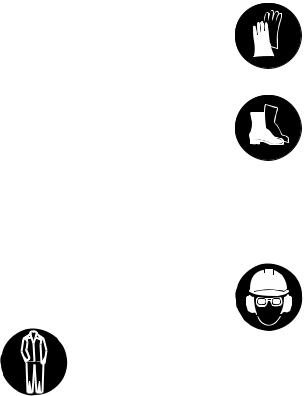
english / USA
These conditions reduce the hand's ability to feel and regulate temperature, produce numbness and burning sensations and may cause nerve and circulation damage and tissue necrosis.
All factors which contribute to whitefinger disease are not known, but cold weather, smoking and diseases or physical conditions that affect blood vessels and blood transport, as well as high vibration levels and long periods of exposure to vibration are mentioned as factors in the development of whitefinger disease. In order to reduce the risk of whitefinger disease and carpal tunnel syndrome, please note the following:
–Wear gloves and keep your hands warm.
–Keep the saw chain sharp and the saw well maintained. A dull chain will increase cutting time, and pressing a dull chain through wood will increase the vibrations transmitted to your hands. A saw with loose components will also tend to have higher vibration levels.
–Maintain a firm grip at all times, but do not squeeze the handles with constant, excessive pressures. Take frequent breaks.
All the above mentioned precautions do not guarantee that you will not sustain whitefinger disease or carpal tunnel syndrome. Therefore, continual and regular users should monitor closely the condition of their hands and fingers. If any of the above symptoms appear, seek medical advice immediately.
!Warning!
According to STIHL's current knowledge, the electric motor or this unit should not interfere with a pacemaker. When in doubt, however, consult their physician and the pacemaker manufacturer before operating this tool.
Proper Clothing
!Warning!
To reduce the risk of injury, the operator should wear proper protective apparel.
Clothing must be sturdy and snug-fitting, but allow
complete freedom of movement. Avoid loose-
fitting jackets, scarfs, neckties, jewelry, flared or
cuffed pants, unconfined long hair or anything that could become entangled with the saw or brush. Wear overalls or jeans with a reinforced cut retardant insert or cut retardant chaps.
Protect your hands with gloves when handling saw and saw chain. Heavy-duty, nonslip gloves improve your grip and protect your hands.
Good footing is most important in chainsaw work. Wear sturdy boots
with nonslip soles. Steeltoed safety boots are recommended.
Never operate a chainsaw unless wearing goggles or properly fitted safety glasses with adequate top and side protection complying with your national standard.
Wear an approved safety hard hat to protect your head. Chainsaw noise may damage your
hearing. Always wear sound barriers (ear plugs
or ear mufflers) to protect your hearing. Continual and regular users should have their hearing checked regularly.
5
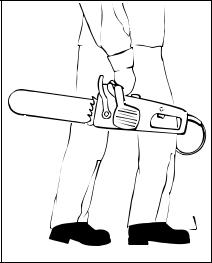
english / USA
THE SAW
Parts of the chainsaw; for illustrations and definitions of the parts see the chapter on "Main Parts of Saw".
!Warning!
Never modify a chainsaw in any way. Only attachments and parts supplied by STIHL or expressly approved by STIHL for use with the specific STIHL saw models are authorized. Although certain unauthorized attachments are usable with the STIHL powerhead, their use may, in fact, be extremely dangerous.
THE USE OF THE SAW
Transporting the chainsaw
!Warning!
Always fully release the trigger switch and make sure the chain has stopped moving before putting the saw down or carrying it. When carrying the saw over longer distances, disconnect the plug and reposition the extension cord.



 001BA069 LÄ
001BA069 LÄ
By hand: When carrying the chain saw by hand, it must be switched off and the saw held in the proper position, i.e. it should be gripped by the front handle. The chain guard must be fitted, even when carrying the saw only a short distance, and the guide bar must point backwards, away from the direction in which you are going.
Do not carry the machine by the power cable. Carry the cable in your hand. If the cable is dragged on a rough surface (concrete etc.) the cable may become damaged.
By vehicle: The chain guard must be fitted on the guide bar when transporting the saw in a vehicle. The saw should be secured so that it cannot move and become damaged, or cause damage.
Preparation for the use of the saw
Always disconnect the plug when the saw is not in use. Take off the chain guard and inspect for safety in operation. Insure that the trigger switch will not engage when the trigger interlock is not pressed. For assembly, follow the procedure described in the chapter "Mounting the Bar and Chain" of your Owner's Manual.
STIHL Oilomatic chain, guide bar and sprocket must match each other in gauge and pitch.
Before replacing any bar and chain, see the sections on "Specifications", "Kickback" and the "ANSI B 175.1-2000 chainsaw kickback standard" in this manual.
6
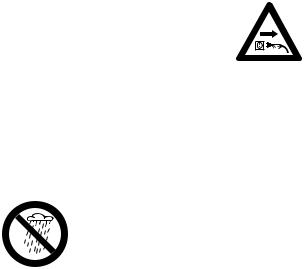
english / USA
!Warning!
Proper tension of the chain is extremely important. In order to avoid improper setting, the tensioning procedure must be followed as described in your manual. Always make sure the hexagonal nut(s) for the sprocket cover is (are) tightened securely after tensioning the chain. Never start the saw with the sprocket cover loose. Check chain tension once more after having tightened the nut(s) and thereafter at regular intervals (whenever the saw is shut off). If the chain becomes loose while cutting, shut off the motor and then tighten. Never try to adjust the chain while the motor is running!
!Warning!
After adjusting a chain, start the saw, let the motor run for a while, then switch motor off and recheck chain tension. Proper chain tension is very important at all times.
Electric Precautions
Special precautions for electric saws must be observed to reduce the risk of personal injury and property damage from fire and electric shock.
This electric chain saw is double insulated.
!Warning!
To reduce risk of serious or fatal injury from electrocution, never use your machine if casing around motor is cracked or damaged.
!Warning!
The electrical power voltage must agree with the voltage specified on the saw's name plate. Improper voltage may cause the motor to overheat, which will damage the saw and may cause personal injury.
!Warning!
To reduce the risk of electrocution never work
in rain or wet places - the electric motor is not waterproof! Do not leave the chain saw outdoors in
the rain and do not operate it if it shows any signs of dampness.
!Warning!
To reduce the risk of personal injury from fire and explosion, do not use the saw in the presence of flammable liquids or gases. The sparks from an electric saw may be a source of ignition!
!Warning!
Inspect the power cable before and after each use
for signs of damage or
aging. In order to reduce the risk of serious or fatal injury from electrocution,
never use your machine if the power cable is cut, cracked, worn or damaged. Turn off power at saw, disconnect the plug immediately and have dealer replace such a cable.
Avoid damage to the power cable. Keep it away from heat, oil and sharp edges. Never jerk power cable to disconnect the plug from the wall outlet. To unplug, grasp the plug, not the cable.
Extension cords
!Warning!
To reduce the risk of electric shock, use only extension cords that are intended for outdoor use. These extension cords are identified by a marking „Acceptable for use with outdoor appliances; store indoors while not in use.“
Do not use damaged extension cords. Examine extension cord before using and replace if damaged. Do not abuse extension cord and do not yank on any cord to disconnect. To unplug, grasp the plug, not the cord. Keep cord away from heat, oil and sharp edges.
7

english / USA
If you use an extension cord, be sure to use one heavy enough to carry the current your electric saw will draw. An improper gauged extension cord will cause a drop in wire voltage resulting in loss of power and overheating. Use only extension cords having an electrical rating not less than the rating of the product.
The following table shows the correct size to use depending on cord length and machine label ampere rating.
Minimum wire size for extension cords for 120 Volt appliances:
Cord types: SJW-A or SJTW-A Round jacketed cords.
Using not more than 12 amps
Cord length (ft) |
50 |
100 |
150 |
Wire size (AWG) |
14 |
12 |
10 |
|
|
||
Using not more than 15 amps |
|
||
Cord length (ft) |
50 |
100 |
150 |
Wire size (AWG) |
10 |
* |
* |
* not recommended
Listed by UL, W-A marking on cable jacket indicates "use outdoors". Appropriate extension cords are available in stores spezializing in electrical equipment.
To reduce the risk of electric shock, this appliance has a polarized plug (one blade is wider than the other).This plug will fit in a polarized outlet only one way. If the plug does not fit fully in the outlet, reverse the plug. If it still does not fit, contact a qualified electrician to install the proper outlet. Do not change the plug in any way.
!Warning!
Position the electric cable so that it will not be damaged when using the electric saw. Always keep the electric cable behind the operator and away from the bar and chain. Always be sure that your cable does not become entangled with obstacles or objects. Damaged cables may cause electrocution. If you take a break at your work, always disconnect the cable.
Working Conditions
Operate the chainsaw under good visibility and daylight conditions only.
!Warning !
Your saw is a one person saw. Do not allow other persons to be near the running chain saw. Operate your saw without assistance.
!Warning !
Be sure that the guide bar and chain are clear of you and all other obstructions and objects, including the ground. If the bar nose near the upper quadrant touches an object, it may cause kickback to occur (see section on reactive forces). Never attempt to start the chainsaw when the guide bar is in a cut or kerf.
!Warning!
Use of this product (including sharpening the saw chain) can generate dust, mists and fumes containing chemicals known to cause respiratory disease, cancer, birth defects, or other reproductive harm. If you are unfamiliar with the risks associated with the particular dust, mist or fume at issue, consult your employer, governmental agencies such as OSHA and NIOSH and other sources on hazardous materials. California and some other authorities, for instance, have published lists of substances known to cause cancer, reproductive toxicity, etc. Control dust (such as sawdust), mists (such as oil mist from chain lubrication) and fumes at the source where possible.
8
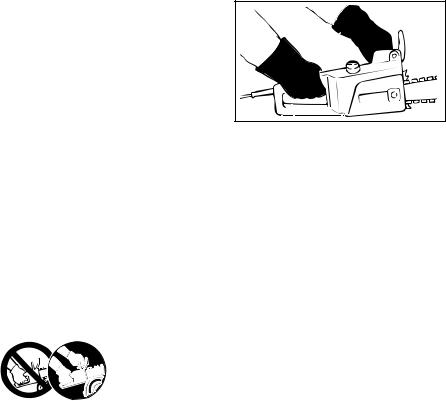
english / USA
In this regard use good work practices and follow the recommendations of OSHA / NIOSH and occupational and trade associations. When the inhalation of toxic dust, mists and fumes cannot be eliminated, the operator and any bystanders should always wear a respirator approved by NIOSH / MSHA for the type substance at issue.
!Warning!
Breathing asbestos dust is dangerous and can cause severe or fatal injury, respiratory illness or cancer. The use and disposal of asbestos containing products have been strictly regulated by OSHA and the Environmental Protection Agency. Do not cut or disturb asbestos, asbestos containing products (e.g. asbestos containing drywall or other construction products), or products such as pipes which are wrapped or covered with asbestos insulation. If you have any reason to believe that you might be cutting asbestos, immediately contact your employer or a local OSHA representative.
Don't work alone. Keep within calling distance of others in case help is needed.
Your chainsaw is equipped with a chain catcher. It is designed to reduce the risk of personal injury in the event of a thrown or broken chain. From time to time the catcher may be damaged or removed.
To reduce the risk of personal injury, do not operate a chainsaw with a damaged or missing catcher.
!Warning!
Avoid stumbling on obstacles such as stumps, roots or rocks and watch out for holes or ditches. Clear the area where you are working. Be extremely cautious when working on slopes or uneven ground. There is increased danger of slipping on freshly debarked logs.
!Warning!
To reduce the risk of serious or fatal
injury to the
operator or bystanders, never
use the saw with one hand.
You cannot control reactive forces and you may lose control of the saw, which can result in the skating or bouncing of the bar and chain along the limb or log.
001BA094LA |
Cutting Instructions
Grip: Always hold the saw firmly with both hands when the engine is running. Place your left hand on front handle bar and your right hand on rear handle and throttle trigger. Left-handers should follow these instructions too.
Wrap your fingers tightly around the handles, keeping the handles cradled between your thumb and forefinger. With your hands in this position, you can best oppose and absorb the push, pull and kickback forces of your saw without losing control (see section on reactive forces). Make sure your chainsaw handles and grip are in good condition and free of moisture, pitch, oil or grease.
9
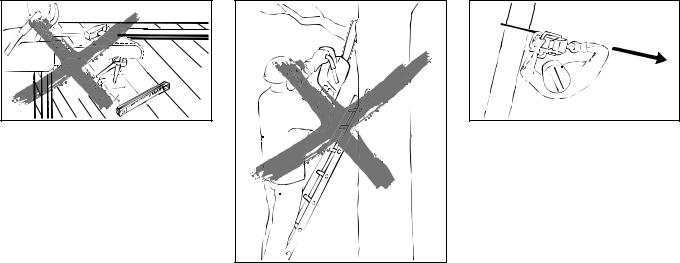
english / USA
LA001BA018 |
!Warning!
Never touch a chain with your hand or any part of your body when the engine is running, even when the chain is not rotating. The chain continues to rotate for a short period after the throttle trigger is released.
!Warning!
Do not cut any material other than wood or wooden objects. Use your chain sawing only. It is not designed for prying or shoveling away limbs, roots or other objects. When sawing, make sure that the saw chain does not touch any foreign materials such as rocks, fences, nails and the like. Such objects may be flung off, damage the saw chain or cause the saw to kickback.
!Warning!
In order to keep control of your saw, always maintain a firm foothold.
001BA031 KN
Never work on a ladder, or on any other insecure support. Never use the saw above shoulder height.
!Warning!
Never work in a tree unless you have received specific, professional training for such work, are properly secured (such as tackle and harness system or a lift bucket), have both hands free for operating the chainsaw in a cramped environment and have taken proper precautions to avoid injury from falling limbs or branches.
001BA082 KN
Position the chainsaw in such a way that your body is clear of the cutting attachment whenever the engine is running. Stand to the left of cut while bucking.
Don't put pressure on the saw when reaching the end of a cut. The pressure may cause the bar and rotating chain to pop out of the cut or kerf, go out of control and strike the operator or some other object. If the rotating chain strikes some other object, a reactive force may cause the moving chain to strike the operator.
Reactive forces including kickback
!Warning!
Reactive forces may occur any time the chain is rotating. Reactive forces can be dangerous! In any chainsaw,
10
